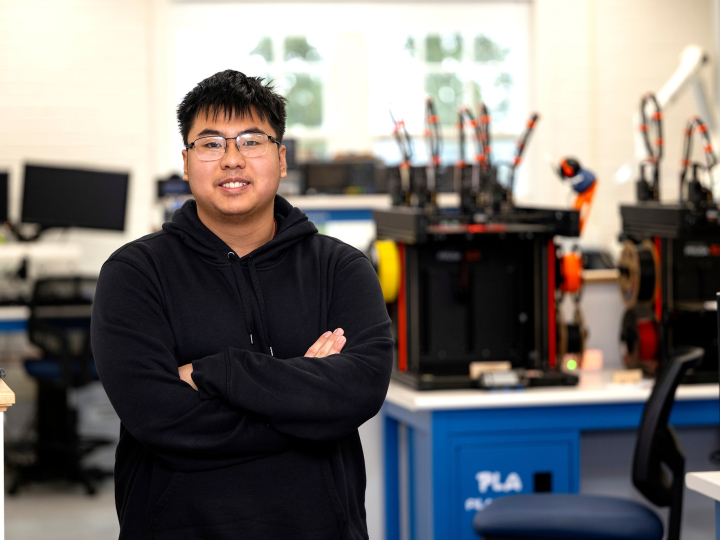Engineering Dean Patrick Mather Awarded NSF Grant to Develop Next-generation Biomaterials
September 26, 2016
When human knees wear out, medicine's approach to helping patients cope is not unlike fixing a broken piece of a car's suspension — doctors surgically swap the worn-out original with a synthetic replacement. While it's a common surgery that more than a half-million Americans undergo each year, it's complex and necessitates a long recovery period.
Patrick Mather, the new dean of the College of Engineering at Bucknell University, wonders if the same result can't be achieved through a much less invasive approach: making a smaller incision to insert a scaffold seeded with the patient's own cells, which then regenerate the cartilage that has worn out over time.
A $360,000 National Science Foundation grant awarded in August is helping Mather and two collaborators from Syracuse University take one step closer to making that concept, and countless other applications of tissue engineering, a reality.
"The future of human health will be to replace our tissues and organs to address disease or injury," Mather said. "We would take cells — and increasingly it looks like we can harvest stem cells just from your skin — grow them in culture until we have enough, and seed them onto a scaffold in the appropriate shape"
"There would still be surgery, but it would be much less dramatic," he continued. "And there's no immune response to be concerned about when we put this back into your body — it's your own tissue."
Knee surgery is an apt example of the technology's promise since Mather's two collaborators (Syracuse University professors Jay Henderson and Ian Hosein) specialize in orthopedic biomaterials, but Mather explained that smart biomaterials have potential to impact a wide range of medical fields, helping patients regenerate ligaments, muscles and even whole organs.
The team's research involves creating polymer scaffolds on which cells can be seeded and grown. The scaffolds resemble sheets of gauze, yet they can change their shape when exposed to elements such as water and heat. Mather likens the material to a rubber band that's been stretched and then flash-frozen with liquid nitrogen. It wants to return to a shorter length, but has no mobility to get there until it thaws. For the new materials, this state of suspended animation (a material "pause") exists at body temperature; heating or hydrating the material can then reanimate the material, like hitting the "play" button. The team is specifically interested in biomaterials that respond to enzymatic actions of cells and to light — both novel reactions for smart biomaterials.
Much of the experimental material will be produced by students, who are the main beneficiaries of the grant at Bucknell. Of the total grant, $60,000 is dedicated to Bucknell, all of which will support stipends for undergraduate and master's-level student researchers over the next three years.
Under the guidance of Mather and Syracuse University graduate student Matt Ali, a visiting scientist in Mather's lab, student researchers will "print" polymer sheets using an electro-spinning machine.
"I'm helping set up the new lab and working with the new machine," said Allison Horn '18, who began working with Mather this fall. "I would never have the opportunity to become as adept at using this technique without working with Dean Mather. I'm excited to learn how to apply knowledge from my classes to create a useful product."
Housed in a Plexiglas box, the electrospinner, which was purchased by Bucknell this summer, contains a horizontally-mounted metal drum roughly one foot long and four inches in diameter, which spins. A frame stands above the drum holding metal syringe nozzles on each side, connected by tubes to pumps. Turn the device on, and it can spray a blend of two different polymers and solvent through the nozzles, which can, along with the drum, be electrically charged. The nozzles and drum are charged to opposing polarities, which serves to draw the polymer onto the drum in whiplike strands, thinner than a single micron. A human hair, by comparison, is about 30 microns wide.
To create materials that achieve the effect they want, Mather and his team need to find the right "recipes" for polymer/solvent blends that go into the syringes, as well as the right voltage and spin speed.
"There are many combinations of materials possible, so we'll be making a ton of materials," Mather said. "Ninety percent of what we make will not do what we want it to do. Everything needs to be just right. Considering the challenge ahead, one of my jobs as the lab leader will be to keep everybody motivated."
Additional biological work will be completed at Syracuse. Mather intends to bring his students to the labs there to hand-deliver prototypes.
Eventually, Mather and his co-researchers hope to refine a production process that can be patented, and which will have applications in a wide range of biomedical and clinical fields.
Even if they don't reach that goal in the span of this grant, "we're discovering new knowledge and compositions," Mather said. "We will be excited to share the news with our scientific peers."

